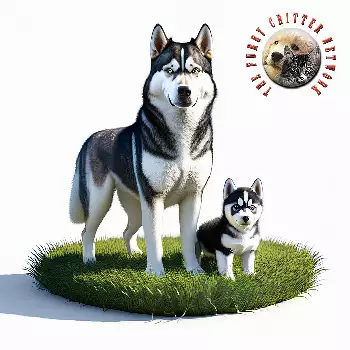Beaski
Hybrid Breed Description
The Beaski is a cross between the Beagle and the Siberian Husky. Because each hybrid inherits a unique combination of traits from both parents, we recommend thoroughly researching both breeds before choosing a Beaski. Pay special attention to temperament, health issues, and care requirements, as your dog may express characteristics from either parent breed.
Beagle

Beagles are compact, muscular scent hounds recognized in two size varieties by breed standards. The smaller variety stands thirteen inches or under at the shoulder and typically weighs under twenty pounds, while the larger variety measures between thirteen to fifteen inches tall and weighs twenty to thirty pounds. Despite their relatively small stature, Beagles possess a solid, sturdy build with substantial bone structure that provides the endurance needed for their original purpose of tracking game over long distances. Their bodies are slightly longer than tall, creating a balanced, well-proportioned appearance that suggests strength without heaviness. The breed's distinctive head features a slightly domed skull, square muzzle of medium length, and large, gentle brown or hazel eyes that create the characteristic pleading expression Beagles are famous for. Their long, soft ears hang low and reach nearly to the tip of the nose when drawn forward, helping to capture and direct scent toward their exceptionally sensitive nose. The ears lie close to the cheeks and are covered in fine, velvety fur. Beagles carry their moderately long tails high in a gentle curve, with the tail's white tip historically serving as a flag to help hunters spot their dogs in tall grass and brush. Beagles sport a smooth, dense double coat that provides weather resistance and requires minimal grooming. The most common color pattern is tricolor, featuring black, tan, and white markings in various distributions, but the breed also appears in numerous other color combinations including red and white, lemon and white, and blue tick. The coat sheds moderately year-round with heavier seasonal shedding periods. Their overall appearance conveys a merry, active temperament with an alert expression that reflects their keen hunting instincts and friendly disposition toward people and other animals.
Key Characteristics
Beagles possess one of the most amiable temperaments among all dog breeds, characterized by their friendly, gentle, and cheerful nature. They were bred to hunt in packs, which has resulted in dogs that are exceptionally social and get along well with other dogs, pets, and people of all ages. Their even-tempered disposition and patience make them particularly excellent companions for families with children, though their enthusiasm during play requires supervision with very young kids. Beagles rarely show aggression and are typically too friendly to serve as effective guard dogs, though they will bark enthusiastically to announce visitors or interesting scents. The breed's defining characteristic is their extraordinary sense of smell and single-minded determination when following a scent trail. This powerful hunting instinct means Beagles can become completely absorbed in tracking, making recall training challenging and necessitating secure fencing and leashed walks. Their intelligence is evident in their problem-solving abilities, but this combines with a notable stubborn streak inherited from generations of independent hunting work. Training requires patience, consistency, and positive reinforcement methods, as Beagles may choose to follow their nose rather than commands. They respond particularly well to food-based training rewards given their hearty appetite and food motivation. Beagles are energetic, curious dogs that require substantial daily exercise and mental stimulation to prevent boredom-related behavioral problems. Without adequate activity, they may develop destructive chewing habits, excessive barking or their characteristic bay-howling, and attempts to escape confinement to explore. They thrive on companionship and can suffer from separation anxiety if left alone for extended periods, potentially leading to vocalization that neighbors may find troublesome. Their playful, often comical behavior and affectionate nature make them delightful companions for active families who can provide the exercise, training, and attention these social hounds need to be happy and well-adjusted.
Beagles are generally healthy, hardy dogs with an average lifespan of twelve to fifteen years. However, the breed is predisposed to certain health conditions that prospective owners should understand. Obesity represents one of the most significant health risks for Beagles due to their exceptional appetite, food-seeking behavior, and tendency to overeat when given the opportunity. Excess weight exacerbates other health problems including joint issues, diabetes, and heart disease. Maintaining appropriate body condition through careful portion control and regular exercise is essential, as Beagles will use their intelligence and determination to access food sources that should be inaccessible. Orthopedic problems occur with notable frequency in the breed. Hip dysplasia, where the hip joint develops abnormally, can cause pain, lameness, and arthritis, though it appears less commonly in Beagles than in many larger breeds. Intervertebral disc disease affects the spine, potentially causing pain, weakness, or paralysis, particularly in overweight dogs. Luxating patella, where the kneecap slips out of position, can range from mild to severe and may require surgical correction. Maintaining healthy weight significantly reduces the risk and severity of these conditions. Beagles face several other health concerns that warrant attention. Epilepsy, a neurological disorder causing seizures, has a genetic component in the breed and typically manifests between six months and five years of age, requiring lifelong medication management. Hypothyroidism, an endocrine disorder where the thyroid produces insufficient hormones, causes weight gain, lethargy, and skin problems but responds well to medication. The breed's long, floppy ears create a warm, moist environment conducive to ear infections, making regular cleaning and monitoring essential. Eye problems including cherry eye, glaucoma, and progressive retinal atrophy can also occur. Dental disease affects Beagles at higher rates than many similarly-sized breeds, making regular dental care including professional cleanings important for overall health.
Siberian Husky

The Siberian Husky is a medium-sized working dog breed built for endurance, speed, and efficiency in pulling light loads over long distances in harsh Arctic conditions. Males typically stand twenty-one to twenty-three and a half inches at the shoulder and weigh forty-five to sixty pounds, while females are slightly smaller at twenty to twenty-two inches tall and thirty-five to fifty pounds. The breed's body is slightly longer than tall, creating a balanced profile that emphasizes power combined with agility and grace. Their compact, athletic build features well-developed muscles without excessive bulk, reflecting generations of breeding for stamina rather than raw strength. Siberian Huskies possess a thick, plush double coat consisting of a soft, dense undercoat and a medium-length outer coat of straight guard hairs that provides exceptional insulation against extreme cold. The coat comes in a wide variety of colors and patterns including black, gray, red, agouti, sable, and white, often with distinctive facial markings resembling masks, caps, or spectacles. Many Huskies display dramatic white markings on the face, chest, and legs. The breed sheds heavily twice yearly when the undercoat blows out, requiring increased grooming during these periods, though regular brushing helps manage their year-round moderate shedding. The breed's most striking features are often their almond-shaped eyes, which can be brown, blue, or one of each color in striking heterochromia. Their expression conveys keen intelligence mixed with friendly mischief. The moderately sized, triangular ears stand erect and are set high on the skull, covered in thick fur. The well-furred tail, reminiscent of a fox brush, curves over the back in a graceful sickle when the dog is alert or moving but hangs down when relaxed. Siberian Huskies move with a smooth, effortless gait that appears almost floating, reflecting their remarkable efficiency and endurance as sled dogs bred to cover vast distances without tiring.
Key Characteristics
Siberian Huskies are renowned for their friendly, outgoing personalities and love of people, including strangers, which makes them unsuitable as guard dogs despite their wolf-like appearance. They are playful, gentle dogs with an affectionate nature toward family members and typically show patience and tolerance with children when properly socialized. However, their high energy and exuberant play style can be overwhelming for small children. Huskies are pack animals that thrive on companionship and should not be isolated for extended periods, as loneliness can lead to destructive behaviors, excessive vocalization, and escape attempts. The breed's defining characteristic is their strong independent streak combined with exceptional intelligence. Siberian Huskies were bred to make independent decisions while working as sled dogs, resulting in dogs that think for themselves and may not prioritize obedience to commands they perceive as unnecessary. This independence is often misinterpreted as stubbornness, but it reflects their heritage of being trusted with mushers' lives. Training requires patience, consistency, and positive reinforcement methods that convince the Husky that cooperation benefits them. They excel at problem-solving, which unfortunately extends to figuring out how to escape from yards and homes through climbing, digging, or manipulating latches. Siberian Huskies possess intense prey drive and an overwhelming instinct to run, making secure fencing and leashed walks absolutely essential. They will chase small animals including cats, squirrels, and livestock, and their running instinct can override their attachment to owners if given the opportunity. Without sufficient exercise and mental stimulation, Huskies become bored and may engage in destructive chewing, digging, and excessive vocalization. Rather than barking, Huskies are famous for howling and producing a variety of distinctive vocalizations. They require substantial daily exercise, thriving with activities like jogging, hiking, and pulling sports that channel their natural abilities. Their friendly, energetic, independent nature makes them rewarding companions for active, experienced owners who understand and appreciate their unique characteristics.
Siberian Huskies are generally healthy, robust dogs with an average lifespan of twelve to fourteen years, though some individuals live considerably longer. The breed was developed under harsh conditions with selective pressure for health and efficiency, resulting in fewer genetic health problems than many purebred breeds. However, several inherited conditions warrant attention from prospective owners. Eye disorders represent the most significant health concern, with multiple genetic conditions affecting vision. Progressive retinal atrophy causes gradual degeneration of light-sensing cells in the retina, leading to night blindness initially and eventual complete blindness. Juvenile cataracts can appear as early as three months of age, causing lens opacity that may require surgical removal. Corneal dystrophy creates cloudiness in the cornea, while glaucoma involves dangerous increases in eye pressure that can cause pain and blindness. Orthopedic problems occur less frequently in Huskies than in many comparably-sized breeds, but hip dysplasia can still affect the breed, causing joint pain, arthritis, and mobility issues. Maintaining healthy weight and avoiding excessive jumping during puppyhood helps minimize risk. Some Huskies develop degenerative myelopathy, a progressive neurological disease similar to Lou Gehrig's disease in humans, causing gradual hind limb weakness and eventual paralysis. While there is no cure, genetic testing can identify dogs carrying the risk genes. Huskies face additional breed-specific health concerns including hypothyroidism, an endocrine disorder affecting metabolism that causes weight gain, lethargy, and coat problems but responds well to medication. The breed can develop zinc-responsive dermatosis, a skin condition causing hair loss in certain areas that improves with zinc supplementation. Epilepsy affects some Huskies, typically appearing between six months and three years of age and requiring lifelong seizure management medication. Uveodermatologic syndrome, an autoimmune condition affecting eyes and skin, can lead to blindness in severe cases. Siberian Huskies may also be prone to certain neurological conditions including polyneuropathy and shaking puppy syndrome in specific genetic lines. Responsible breeders screen for these conditions and avoid breeding affected dogs.
Important to Remember
Each hybrid dog is unique and may inherit any combination of traits from either parent breed. The information above represents the characteristics of the purebred parent breeds. Your Beaski may favor one parent over the other or display a blend of both. We strongly encourage you to read the complete breed profiles for both the Beagle and Siberian Husky to fully understand the range of possible temperaments, health concerns, and care requirements.